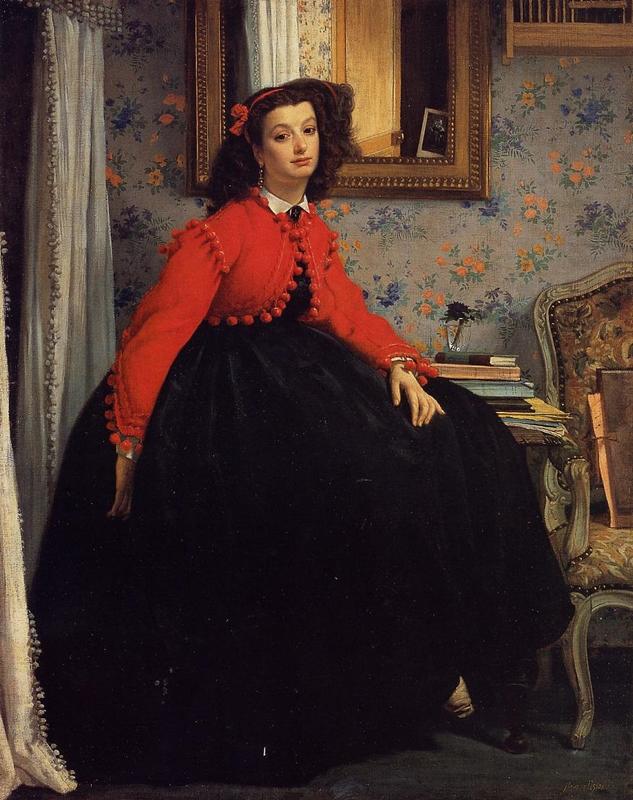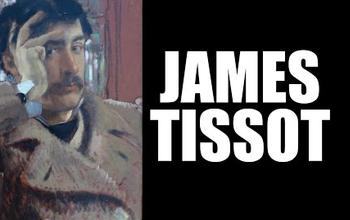More about Portrait of Miss L. L.
- All
- Info
- Video

Contributor
James Tissot knew his way around fashion, and it’s evident in the Portrait of Miss L. L.
The child of a textile merchant (pa) and the owner of a millinery (ma), Tissot had an advantage over his contemporaries when it came to representing modern life giving him an eye for fabric. In the 1860s, he applied his knowledge of modern fashion to his work on modern life, abandoning his earlier themes of historical and religious subjects. In Portrait of Miss L. L., the young model’s red bolero and dark skirt dominate the canvas.
Tissot’s dip into modern life painting came at the perfect time. Paris was a bustling hub of modernity, and from the urbanization of the city, stylish Parisians were the envy of the world. Tissot got to work painting and soon became wealthy from his art.
In the Salon of 1864, Tissot debuted a few things: First there was his new name going from Jacobus to James, really soaking in that English life, screaming “New Year, new me!” Second, the Portrait of Miss L. L. along with The Two Sisters. Tissot’s 1864 Salon paintings were a hit with the critics with one complementing the details of the postcard in the mirror and the used books and sheets on paper sitting on the table beside her. A nice personal touch.
The subject in Portrait of Miss L. L. has yet to be identified. Considering this model is the first full-length figure Tissot had ever painted up ‘til that point, you’d think he would have written down her name. He even used her did use her more than once appearing again in Les deux soers and Le Printemps. In Portrait of Miss L. L., the model has her hair bunched up and squished against the mirror; there’s an awkward dangle of the foot, which should have remained hidden beneath the folds of the dress. Pish posh, minor inconveniences in comparison to the little detail Tissot leaves behind. The blossoming flower apparently means that Mademoiselle L. L. has reached puberty.
Sources
- Desmarais, Charles, “Tissot at the Legion of Honor: a story more of love than of art,” Datebook, October 10, 2019. Date accessed April 22, 2020. https://datebook.sfchronicle.com/art-exhibits/tissot-at-the-legion-of-h…
- Green, Anna, French Paintings of Childhood and Adolescence, 1848-1886. New York: Routledge, 2016.
- Deanna Isaacs, “James Tissot’s tragic muse,” Chicago Reader, August 19, 2013. Date accessed April 22, 2020. https://www.chicagoreader.com/chicago/art-institute-impressionism-fashi…
- Misfeldt, Willard E., The Albums of James Tissot. Bowling Green: Bowling Green University Popular Press, 1982.
- Quinn, Bridget, “James Tissot’s weirdly sexy, astonishingly cinematic and spiritual paintings,” Hyperallergic, November 12, 2019. Date accessed April 22, 2020. https://hyperallergic.com/527694/james-tissot-fashion-faith-legion-of-h…
- Roberta Smith, “Th cross-dressing of art and couture,” The New York Times, February 21, 2013. Date accessed April 22, 2020. https://www.nytimes.com/2013/02/22/arts/design/impressionism-fashion-an…
- Tinetrow, Gary, Loyrette, Henri, Origins of Impressionism. New York: The Metropolitan Museum of Art, 1994.
Featured Content
Here is what Wikipedia says about Portrait of Mademoiselle L.L.
Portrait of Mademoiselle L.L. (French: Portrait de Mademoiselle L.L.) is an 1864 oil painting by the French artist James Tissot. It depicts a young woman wearing a red bolero jacket seated on a small table. The initials in the title are now a mystery although the women had modelled for Tissot before.
It was one of two works that Tissot submitted to the Salon of 1864 along with The Two Sisters, which featured the same model who appeared in this picture. Today the painting is in the collection of the Musée d'Orsay in Paris having been acquired by the French state in 1907.
Check out the full Wikipedia article about Portrait of Mademoiselle L.L.













